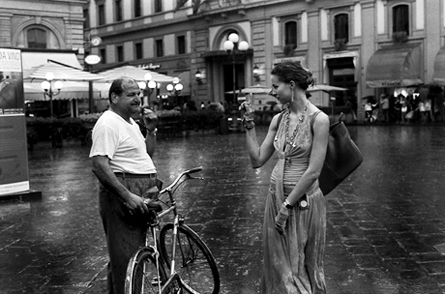
Street theatre and street photography
© Guillermo Labarca
 Street theatre has a long story. Arguably is the oldest form of theatre. It has been attributed to Tespias performances in the agora in sixth b.c. In the middle ages there have been countless theatrical activities in squares, church atrium, markets through Europe. It is an uninterrupted tradition and nowadays has become institutionalized, getting subsidies, organizing festivals, setting up itinerant theater companies. There are also, specially in mediterranean countries theatrical activities that are not considered as such, although they preserve traditions that are at the origin of theatre, some of them organize big scale performances other are more modest. Among the former is worth mentioning semana santa in Seville, Fallas in Valencia, carnival in Venice or Viareggio, Palio in Siena and many others. There are more modest that, nevertheless, are highly regarded and attended. These festivals and celebrations have all the features that characterize a theater performance: actors, audience, a script that tells a story, staging, direction etc.
Street theatre has a long story. Arguably is the oldest form of theatre. It has been attributed to Tespias performances in the agora in sixth b.c. In the middle ages there have been countless theatrical activities in squares, church atrium, markets through Europe. It is an uninterrupted tradition and nowadays has become institutionalized, getting subsidies, organizing festivals, setting up itinerant theater companies. There are also, specially in mediterranean countries theatrical activities that are not considered as such, although they preserve traditions that are at the origin of theatre, some of them organize big scale performances other are more modest. Among the former is worth mentioning semana santa in Seville, Fallas in Valencia, carnival in Venice or Viareggio, Palio in Siena and many others. There are more modest that, nevertheless, are highly regarded and attended. These festivals and celebrations have all the features that characterize a theater performance: actors, audience, a script that tells a story, staging, direction etc.
One of the merits of the street photography in relationship with the street theatre, besides to register its performances, is namely to make theater. What this means? Well, simply that when a photographer makes a meaningful photo of a street event is making theater, he is making a story with what the street has in offer. If we watch photos by Cartier Bresson, Koudelka and many others, or staying close, by Tan Thandukit or Alexander Petrosyan in this issue of this magazine or many others in other issues we may see that these photos have everything that a theater performance has: the framing is in fact a mise en scene, both tell a story, lighting is essential, there are intentions in both activities, they are after a public that is needed to complete the activity.
By establishing the former we realize that the photographer execute many functions from a theater performance. When he takes a photo in the street and later in the dark room or in his or her computer he is the regisseur , the script writer, lightning technician, one spectator and all of it simply with a click